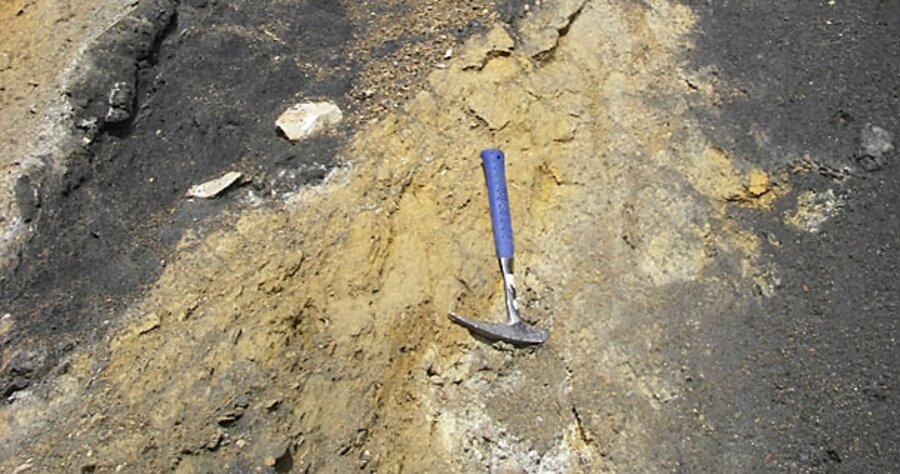Today’s unsettling comparison to ‘the great dying’
Loading...
| New York
In 1980, scientists Luis Alvarez and his son, Walter, proposed a new explanation for the dinosaurs’ disappearance 65 million years ago: a meteor strike. Initially, the idea was met with resistance. But the evidence was convincing: a sediment layer high in iridium, an element common in asteroids, was found the world over, along with a 110-mile-wide impact crater in the Yucatán of the same age. What started as a fringe idea has gone mainstream.
Now scientists are rethinking another of earth’s great die-offs. The end-Permian extinction 251 million years ago was the worst of earth’s five mass extinctions. Ninety percent of all marine life and 70 percent of terrestrial life disappeared. It took five million years, perhaps more, for the biosphere to recover.
But while the die-off was uniquely devastating, evidence of a single cataclysmic event, like an asteroid strike, hasn’t been found in the geological record. Scientists now suspect that “the mother of all mass extinctions” was of Earth’s own making. And the more they learn about it, the more parallels they see to today’s world: A bout of greenhouse-gas-induced global warming, much like today’s, set off a chain of events that culminated in oxygen-depleted oceans exhaling poison gas.
And as in today’s human-dominated earthscape, life was already stressed.
“Something came along and kicked it over the edge,” says Linda Elkins-Tanton, an assistant professor of geology at the Massachusetts Institute of Technology in Cambridge, Mass. She heads a recently launched multidisciplinary effort to study the extinction. “Should there be a great kick [now], we are in a position for a great die-off,”
she says.
Two hundred and fifty million years ago, Earth was emerging from a period of glaciation. The transition from icehouse to greenhouse was already stressing life, scientists think. Then magma began bursting through the crust of what is now Siberia. The eruption was tremendous, says Professor Elkins-Tanton. Over the course of maybe 1 million years, enough lava flowed to cover the continental United States half a mile deep.
The crust through which it bubbled contained vast coal and limestone deposits from an earlier time. As it burned through this fossilized organic material, it released huge amounts of carbon.
Today, by burning fossil fuels, humans are again releasing carbon sequestered long ago, and at a similarly rapid rate.
“There may be some pretty direct parallels between the end-Permian extinction and today,” says Jonathan Payne, professor of geological and environmental sciences at Stanford University in Palo Alto, Calif.
The eruption and release of greenhouse gas was just the beginning. The warmer atmosphere heated the ocean surface, effectively capping the seas with a warmer layer. The result: The overturning of the ocean’s water, which keeps deep waters oxygenated, likely stopped. Deeper waters became oxygen-depleted.
Meanwhile, erosion accelerated on land, says Lee Kump, professor of geosciences at Penn State University, University Park, dumping more fertilizers, like phosphorus, into the seas. High nutrient influx led to plankton blooms. As the organic matter decomposed, it sucked up what oxygen remained – the same process now observed in the world’s dead zones. Widespread ocean anoxia (oxygen depletion) suffocated much oxygen-dependent marine life.
Then came the final blow. In waterways that are anoxic beyond a certain depth, like today’s Black Sea, oxygen-dependent organisms live near the surface and oxygen-avoiding microbes live deeper. Scientists call the boundary between them the “chemocline.” Organisms below the chemocline “breathe” sulfates, not oxygen. Just as oxygen-dependent organisms exhale CO2, these bacteria give off hydrogen sulfide, a gas toxic in high concentrations to many life forms, including plants and animals. The gas neatly explains one of the mysteries of the Permian die-off: how an extinction event that began at sea could have decimated life on land.
Scientists find molecular “signatures” of anaerobic organisms at what was the water’s surface in end-Permian times. Lack of oxygen let sulfate-breathers rise from the ocean deep and spew hydrogen sulfide directly into Earth’s atmosphere.
Hydrogen sulfide would have also eaten holes in the earth’s protective ozone layer. Plants and animals either suffocated directly – atmospheric oxygen levels plummeted to 15 percent (it’s about 21 percent today) – or succumbed to the combination of long-term stresses.
And the lessons for today? At the Permian boundary, “you’re in a state of gradual warming, then as you approach that boundary, the warming increases dramatically,” says Jeff Kiehl, a senior scientist at the National Center for Atmospheric Research in Boulder, Colo. “It wasn’t a linear warming.” Says Professor Kump: “This shows us what could happen if we push the system too hard…. We don’t know where the intermediate thresholds are.”
We’re still some way from the atmospheric CO2 levels hypothesized at the end-Permian extinction – which were perhaps 10 times preindustrial levels, or 2,800 ppm. Yet, according the Intergovernmental Panel on Climate Change, if trends continue we’re still approaching 1,000 ppm of CO2 by 2100. That’s not Permian-extinction levels, but it would be the highest CO2 concentration in 80 million years, and a level at which both ocean anoxia and lesser extinctions have occurred.
“Do we want to put ourselves on a very risky path of possibly repeating earth’s history, or do we want to be more cautious?” says Dr. Kiehl. “I would hope as a conscious species that we would choose the latter.”





